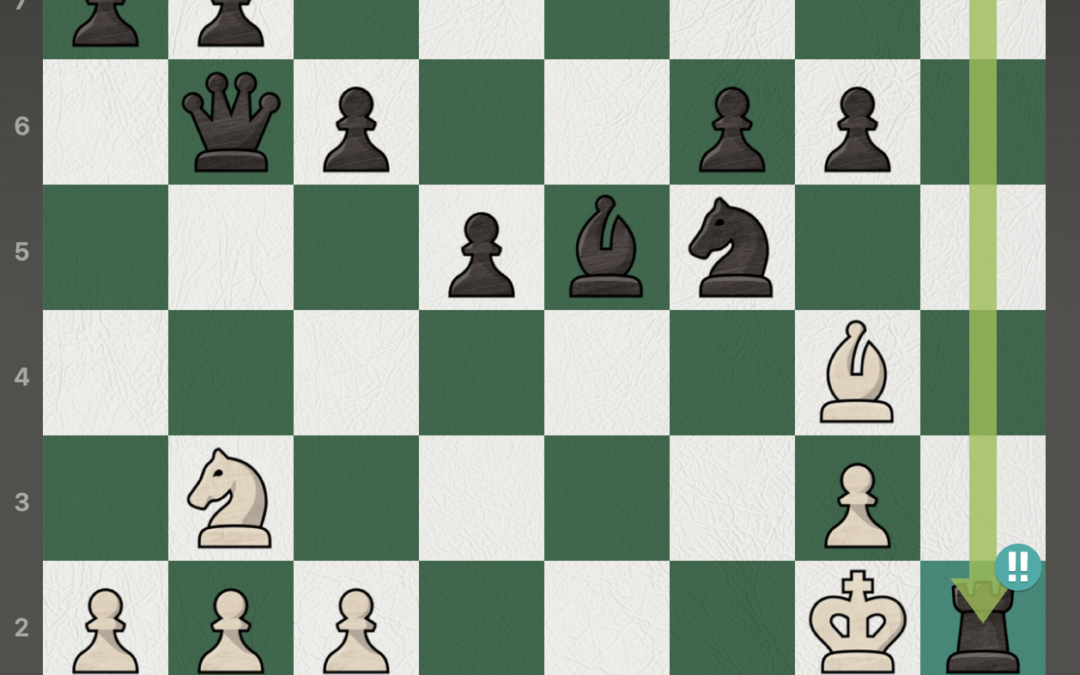I’ve been playing on Chess.com since late 2018. You can find me here or by searching for DoctorAragorn.
I’m what you might call a serious hobbyist.
After each game ends, a Chess.com engine classifies every move into one of the following categories:
• Blunder: A very bad move that also loses material or the game.
• Miss: A move that missed a tactical opportunity or a chance to punish the opponent.
• Mistake: A bad move that immediately worsens your position.
• Inaccuracy: A weak move.
• Book: A conventional opening move.
• Good: A decent move but not the best.
• Excellent: Almost as good as the best move.
• Best: The chess engine’s top choice.
• Great: A move that altered the course of the game!
• Brilliant: The best move — and tricky to find too!
Brilliant moves are rare. Finding them is one of the greatest feelings in chess.
If you’re looking for the most brilliant moves of the greatest grandmasters, here’s a YouTube playlist for you! GM Simon Williams narrates these videos in a wonderful and entertaining way.
Here I’d like to share brilliant moves from some of my own games, both from me and from my opponents. I’ll show a screenshot of the previous move so that you can test yourself which you think might be the upcoming brilliant move before I show a screenshot of the solution.
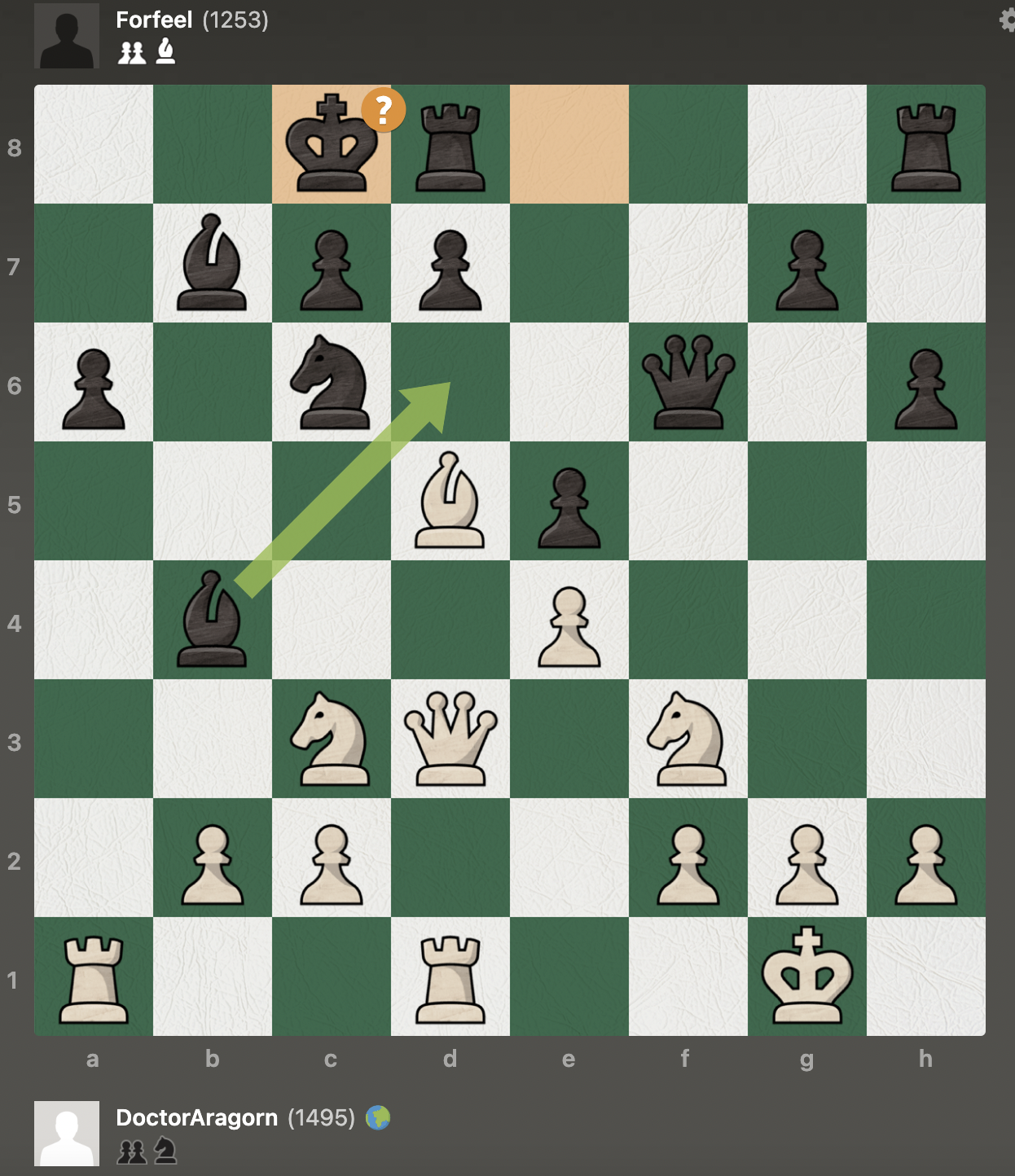
The first brilliant move is from a game that ended on November 10, 2022. This game began in the Italian opening.
My opponent castled longways (O-O-O), and the engine considers this a mistake (this is what the question mark next to the king means).
Instead, the engine suggests Bd6, retreating the dark-squared bishop back to support the pawns on e5 and c7.
If you were playing as the white pieces, what would you do in this scenario to capitalize on black’s mistake?
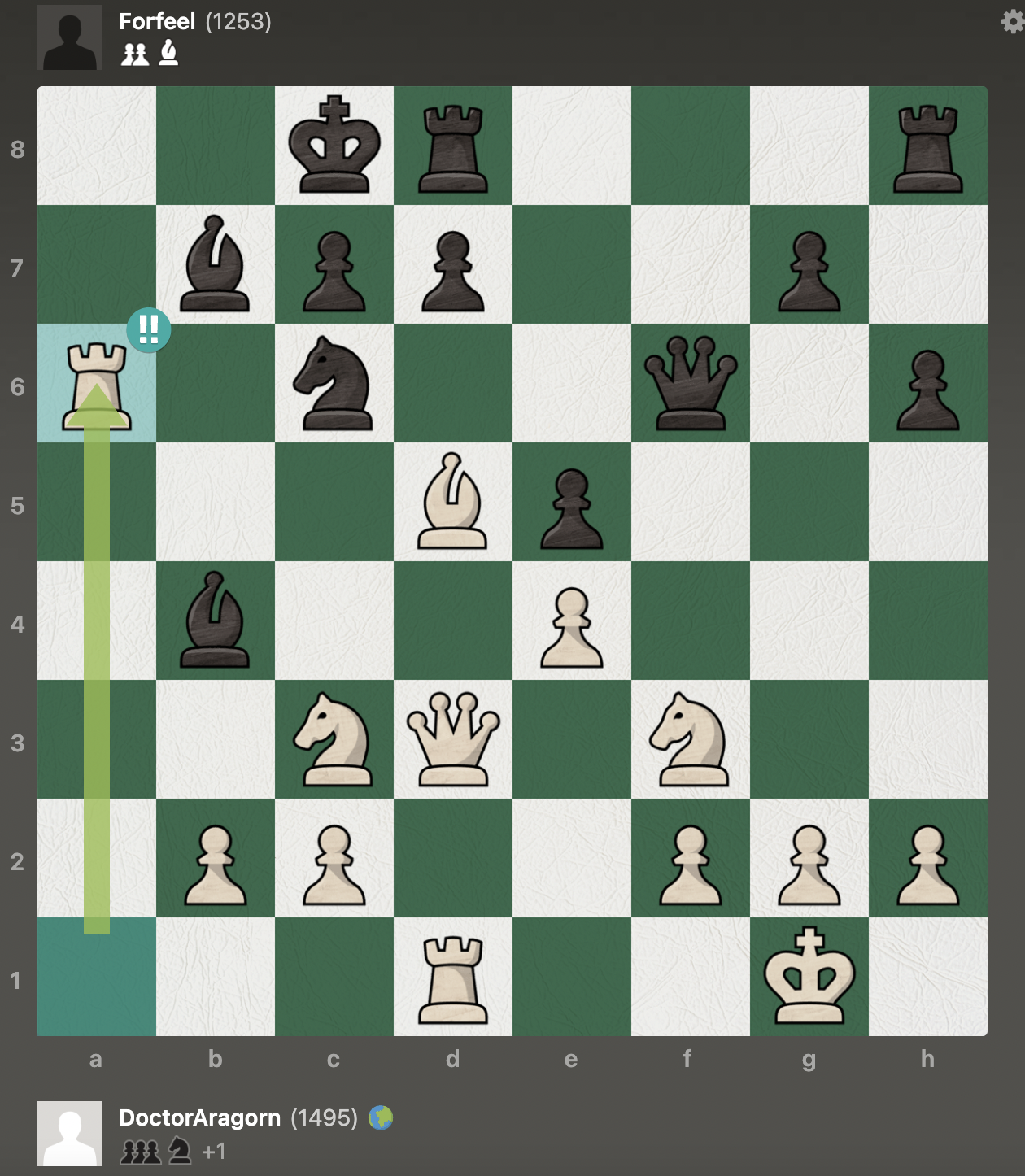
Now that the black king is on c8, a flank attack is a major threat. My move was a rook sacrifice! Rxa6 removes the a-pawn, paving the way towards victory.
If black responds by capturing the rook with his light-squared bishop (Bxa6), then white’s queen can recapture with check (Qxa6+). Black’s only move would be Kb8. White can then slide the other rook over to the corner (Ra1), threatening to move the queen supported by this rook in for checkmate. Black can obstruct the a-file with the dark-squared bishop, either Ba3 or Ba5, but that would only delay the checkmate by one move. White’s light-squared bishop on d5 x-rays a8 and thus prevents black’s knight from moving away from c6.
The engine evaluation at this point is +5.67, as if in agreement that white’s superior position is worth a whole rook and then some. The engine suggests black respond with Qd6, starting to bring the queen over to help with defense in the corner.
Instead, my opponent played Bxc3, and then resigned after I recaptured with my pawn.
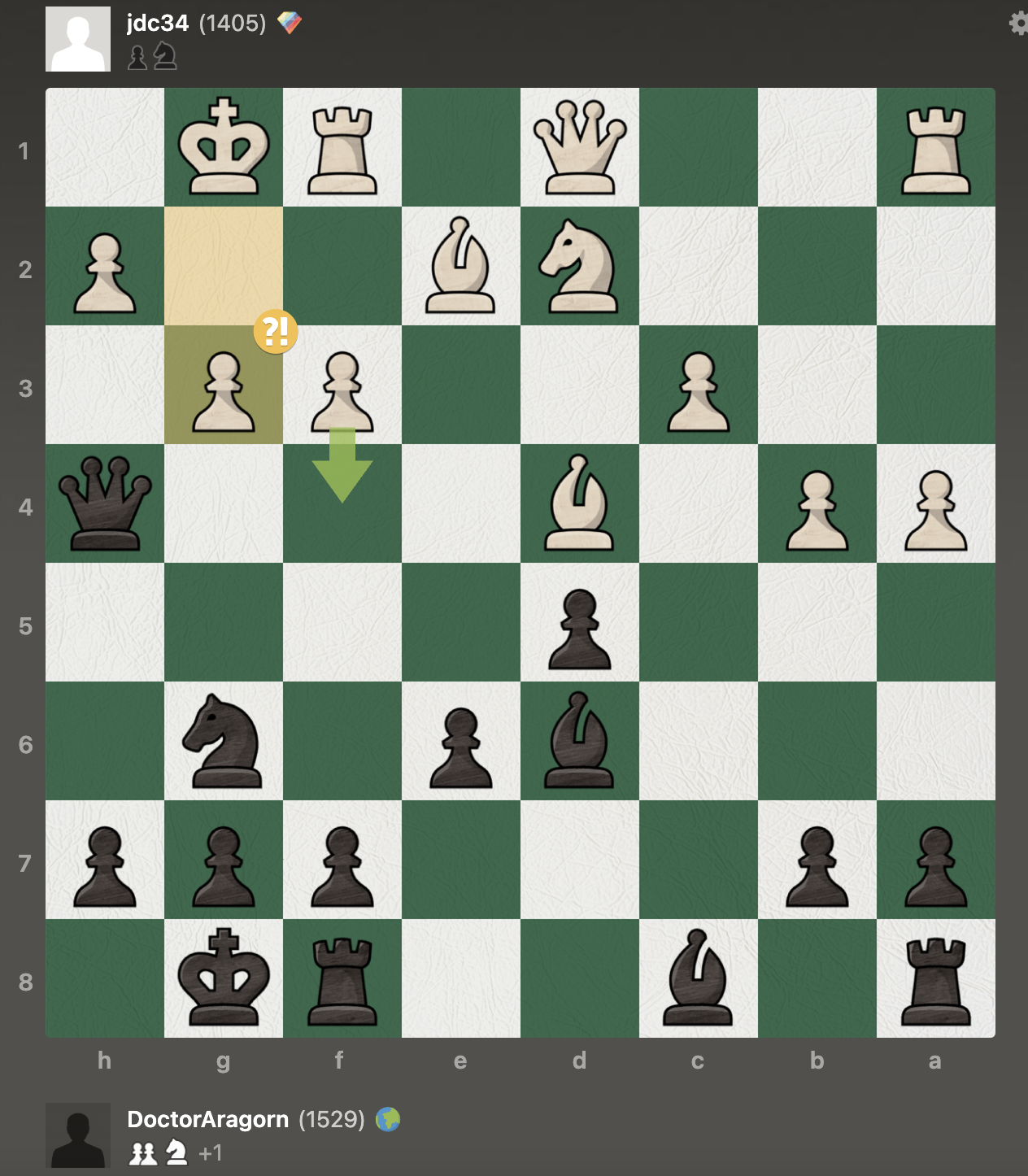
The next brilliant move is from a game that ended on December 30, 2022. This game began in the Caro-Kann opening.
My opponent, playing as white, moved his pawn to g3 to simultaneously attack my queen on h4 and also block the attack of my dark-squared bishop, which was eyeing h2. The engine considers this move an inaccuracy (indicated by the “?!” near the pawn).
The engine suggests that he should have instead moved his f-pawn up to f4. Note that a pawn on f4 would block the bishop’s attack and would be protected by the rook on f1. Nevertheless, that pawn would only be protected by one piece, and would be attacked by three pieces: queen, bishop, and knight.
After white’s g3 move, what would you do as black?

Instead of moving the queen away, I responded with a bishop sacrifice! Bxg3 threatens checkmate on h2, so the bishop is expected to be recaptured by the h-pawn. That is what my opponent did.
One other sensible move would have been Rf2 to defend the checkmate, but that would allow black’s dark-squared bishop to capture the rook, and then black would be up the exchange.
After white plays hxg3, black continues the attack with Qxg3+, and white’s only move is Kh1.
I did not follow this up with the best move, which would have been Qh4+, herding the king back to g1 before bringing the knight up to support the attack.
Instead, I played Nf4 directly, which is considered a mistake. Although it threatens checkmate on g2, white can easily defend it with Rf2.
I did eventually win this game though.
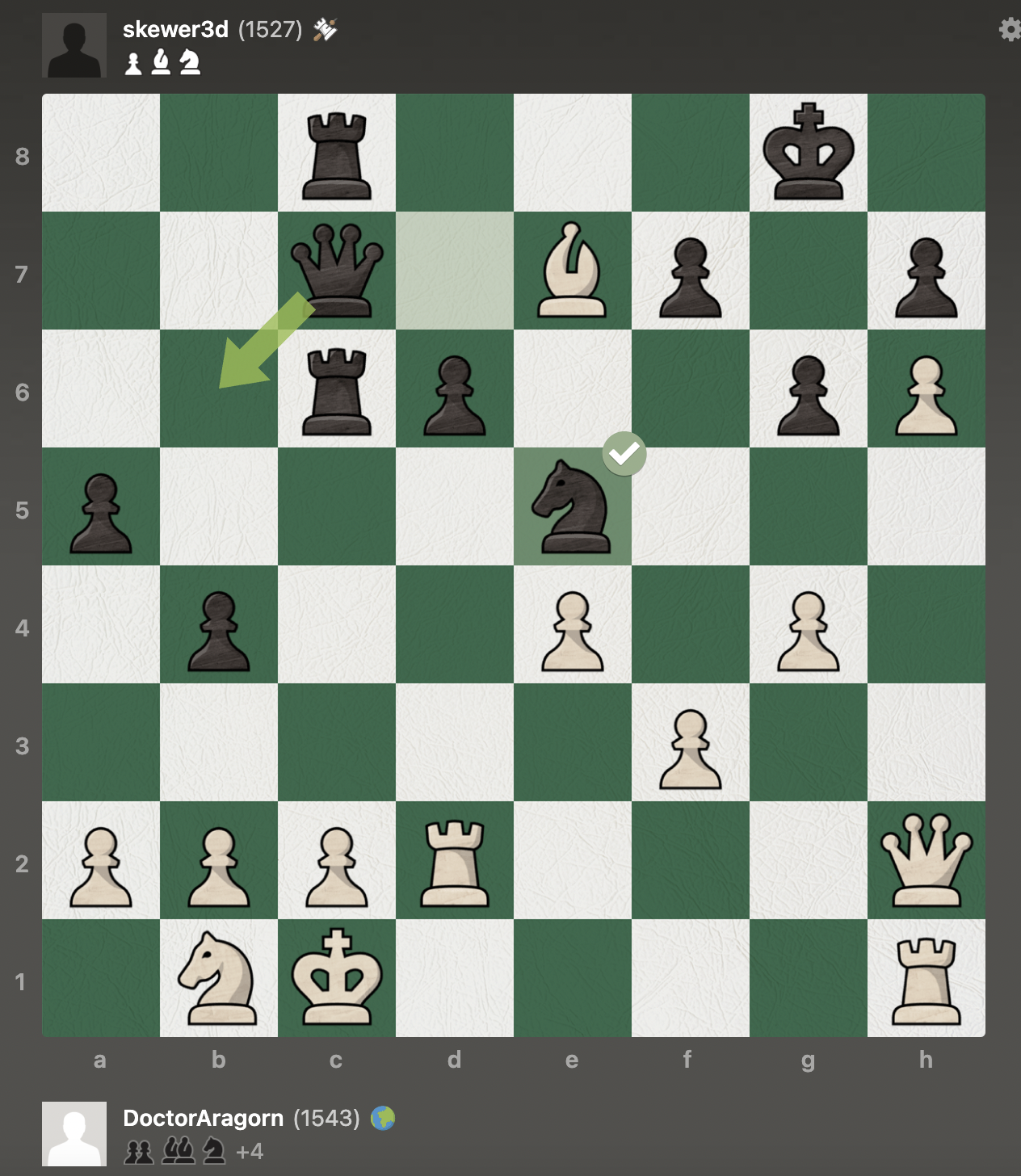
The next move I’d like to showcase comes from a game that ended on January 12, 2023. I was playing as white and was up in material at the time.
Black’s knight had been on d7, and was then moved to e5 (Ne5), revealing an attack from black’s queen on white’s dark-squared bishop.
The engine says Ne5 is a good move, but Nc5 would have been better, and Qb6 would have been the best. The idea is to get to the e3 square to pin the rook on d2 if white leaves its king on c1. Then the pawn on c2 would become extremely vulnerable. That, however, is not what happened.
After black’s Ne5 move, what would you do as white?
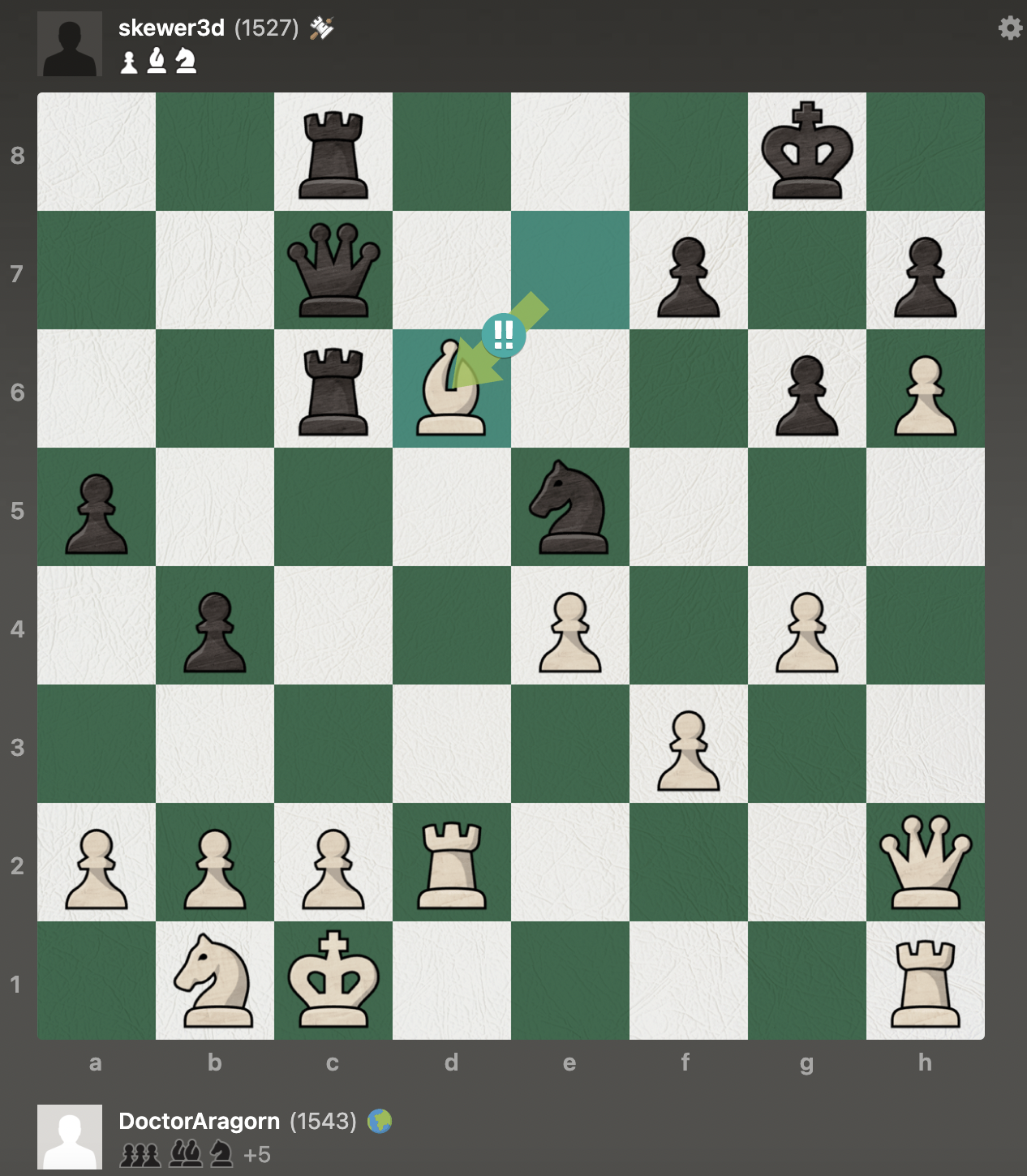
I played Bxd6, sacrificing my bishop! The bishop is defended by the rook that is on d2, but it is attacked by both a rook and a queen. Because the bishop is attacking black’s queen, it is expected not to be ignored.
Taking the bishop, however, would be a mistake. Rxd6 would be a mistake because it allows white to play Qxe5, removing the knight and threatening checkmate on g7. Qxd6 would be a mistake because it loses the queen to white’s rook.
The best response to this, and what my opponent actually played, is Nd3+. The c-pawn can’t take the knight because it is pinned to the king. Capturing the knight with the rook would be a blunder, because it allows Rxc2+, which leads to a nasty comeback.
Instead, I responded with Kd1, sidestepping the check. This is the best move under these circumstances.
After Rxd6 was then played, however, I made the blunder of playing Rxd3, thinking it was now safe, but it was not. Lamentably, I went on to lose this game.
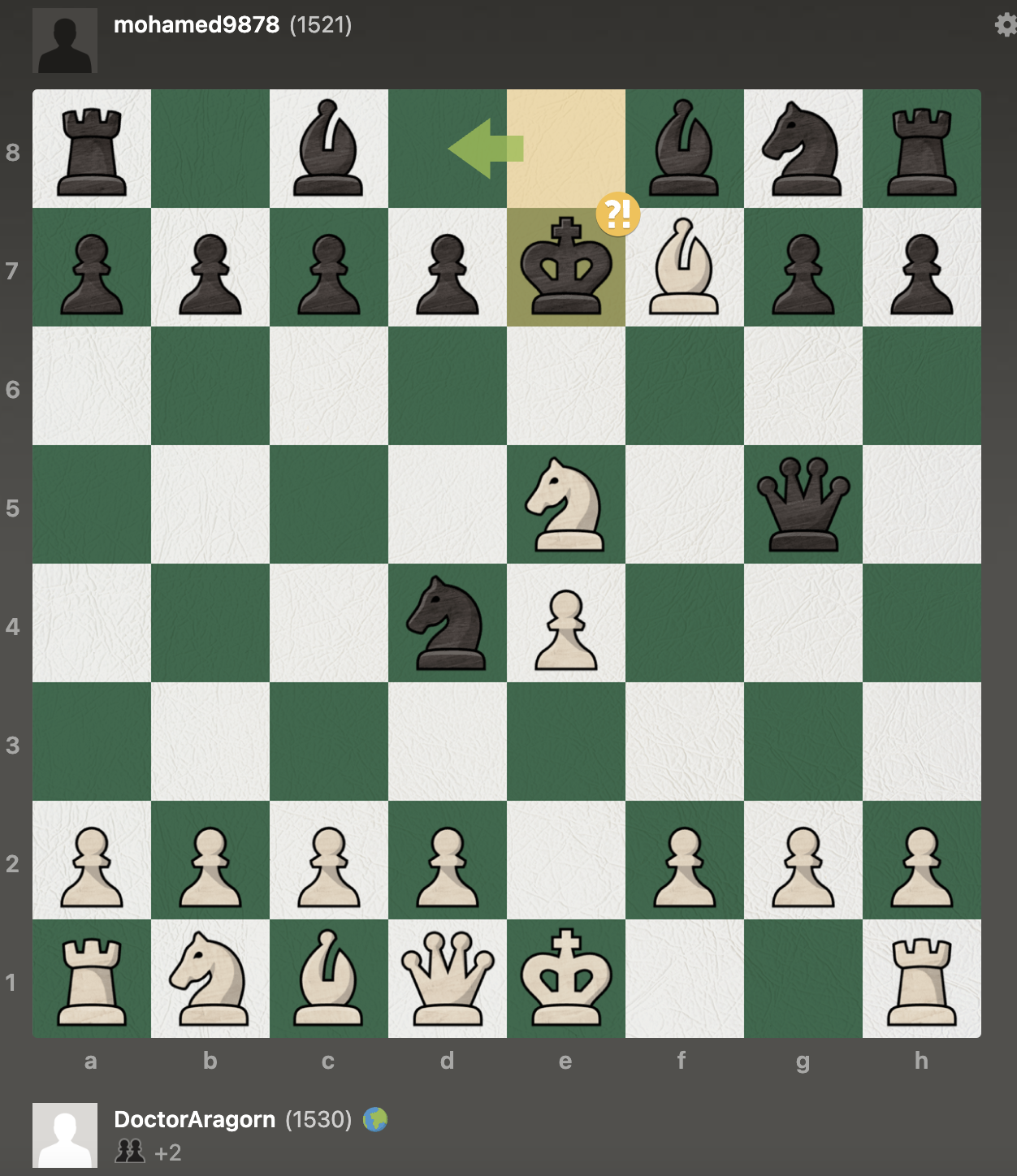
The next move is from a game that ended on January 15, 2023. This was an Italian game in which my opponent played the Blackburne-Shilling Gambit (3. …. Nd4), which I have not faced too many times. I responded by taking the undefended pawn on e5 instead of recapturing the knight. This is something I don’t think I’ll do again.
Qg6 is a book move that threatens the knight as well as the g-pawn.
I responded with Bxf7+, which is the best move under the circumstances.
Black should have then tucked his king away at d8, but instead played Ke7, which is an inaccuracy.
From here there is only one move that keeps the evaluation in white’s favor. Can you guess what it might be?
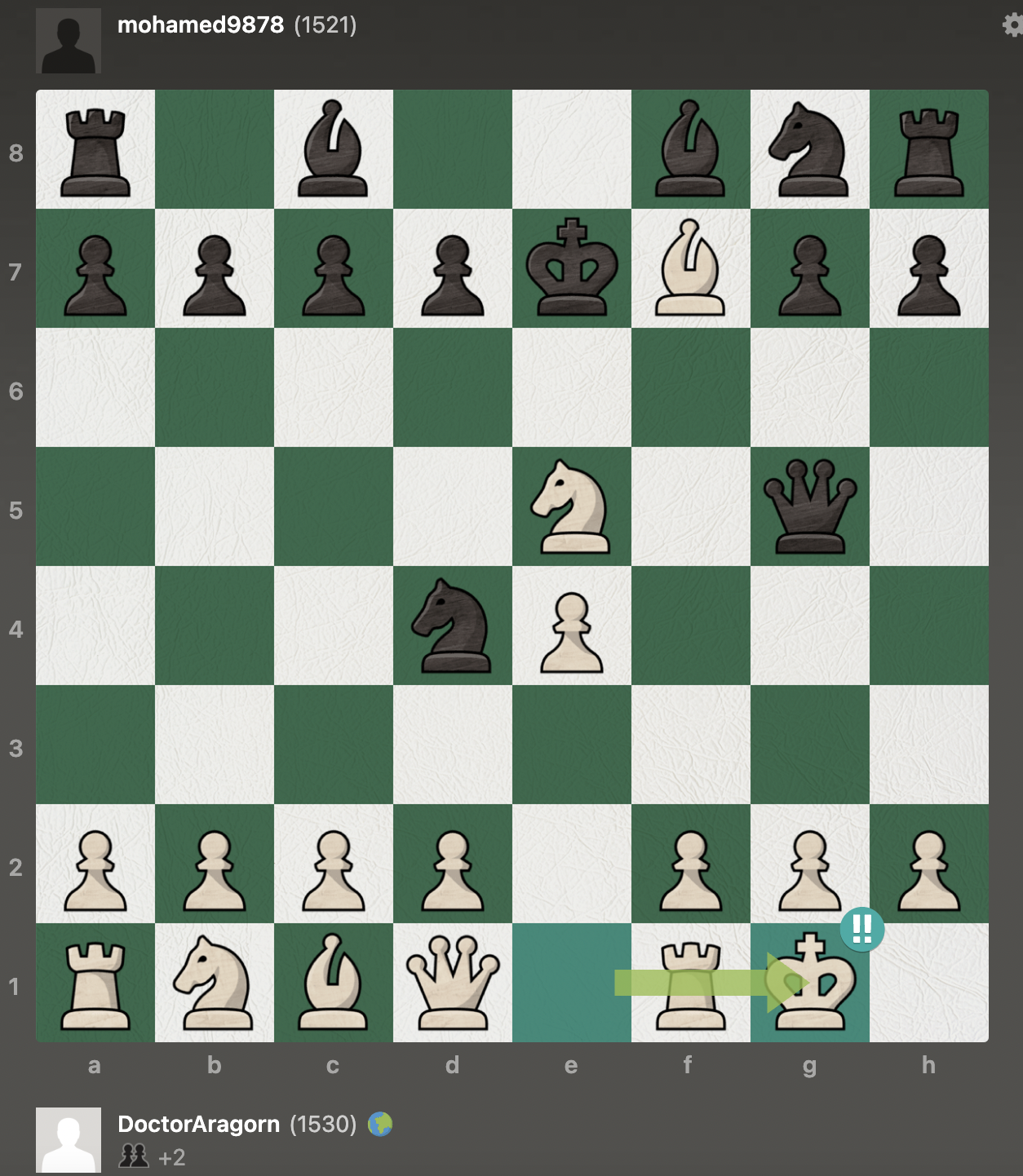
It turns out castling here is considered brilliant!
It allows black’s queen to capture the knight, but moves white’s king into safety.
After black plays Qxe5, which is what my opponent played, white should then play Bd5, protecting both bishop and e-pawn.
Instead, I played Bxg8, removing the knight. This is an inaccuracy.
I went on to charge forward with my e- and f-pawns, but black was able to halt them.
Both sides missed good opportunities, and black won this game in the end.
It was the only game in 6 games against this opponent that I lost.

The next move is from a game that ended on January 16, 2023. This game began with the Alekhine’s Defense position.
I had already charged with my king’s pawns and removed my opponent’s king’s pawns.
My opponent played Bxb2, which is an inaccuracy. It does threaten my rook on a1, but Rh7 would have been better, pinning my dark-squared bishop to my king.
After Bxb2, what would you play as white?
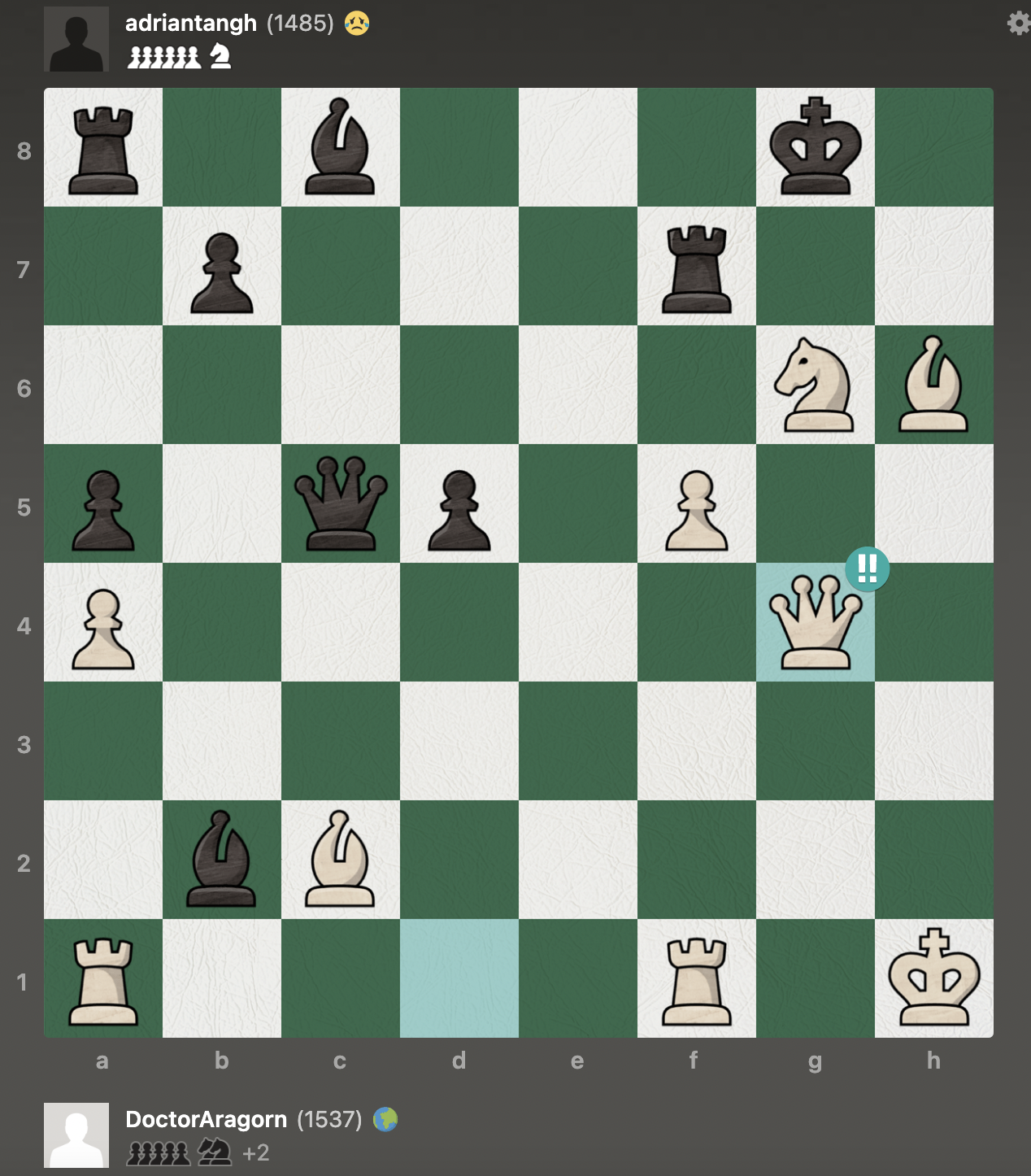
I played Qg4, focusing on the attack!
In this position, Bxa1 would allow two possible inescapable checkmates in 3 moves. Can you find these mating sequences?
Hint: Both of these begin with a knight move, which allows a discover check by the queen.
Solution 1: 29. Ne5+ Kh7 30. Qg6+ Kh8 31. Nxf7#
Solution 2: 29. Ne7+ Kh7 30. Qg6+ Kh8 31. Qg8#
Note that Kh8 is permitted but allows an immediate checkmate by Qg8#.
My opponent did not play Bxa1, though. He played Bg7, retreating the bishop for defense. This is the best move under these circumstances.
I continued my attack with Ne5, which is an inaccuracy. Although it does protect my dark-squared bishop by placing a pin on my opponent’s dark-squared bishop, as well as threaten the rook on f7, the engine considers Rae1 to have been the best move here, as the black king is not defended from the side.
After we exchanged queens on move 31, I went on to win this game. My opponent resigned on move 42.

Now comes the part with more learning for me, as I’ll go through a few brilliant moves made by my opponents.
Not one but two of these came in a game that ended on January 18, 2023. I played the Caro-Kann Defense in this game, and my opponent opted for the Advance Variation.
My opponent took my g7 pawn with his h-pawn. I played Kg7, capturing his pawn with my king. This is considered excellent, although the best move would have been Rfc8, giving my king space to escape.
If you were playing as white, what would you do in this position?
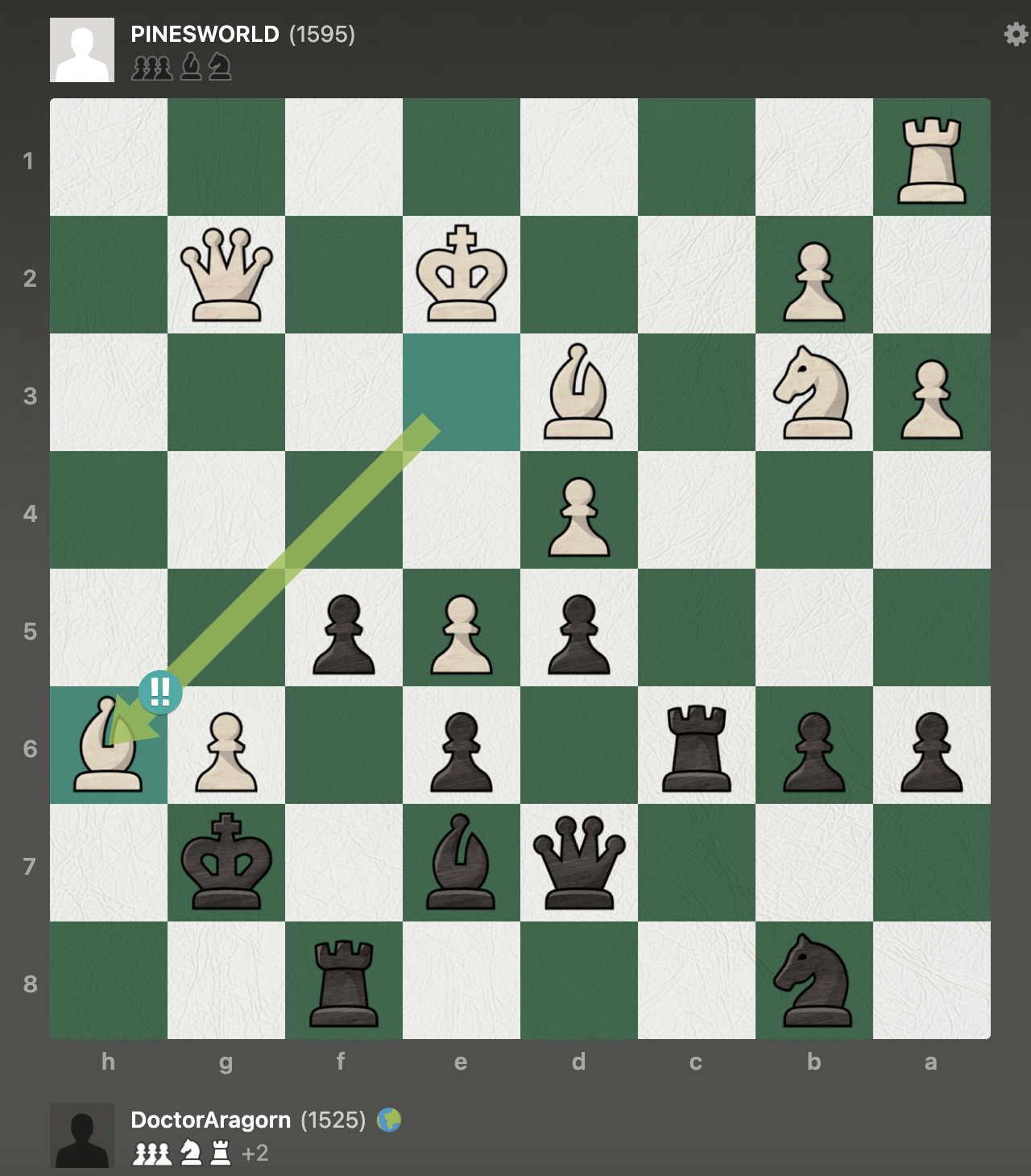
My opponent played Bh6+, offering his bishop for “free”!
It would not really be for free because capturing his bishop with my king would lead to a mate in 7. His rook and queen would have an indefensible attack down the h-file.
I played Kg8, which lets his bishop take my rook, but is the only escape from checkmate.
He did not take my rook immediately though. Instead, he played Qh3, which is excellent.
I responded with Qe8, attacking the pawn on g6. He then played Rg1 to defend that pawn.
The next move will be discussed in the following panel, setting up his second brilliant move of the game.

I played the move a5, perhaps out of desperation, not knowing what I could do to defend my king. The engine does classify this move as good.
The engine suggests that the optimal move in this position would have been Rc7. Indeed, the rook would have been able to provide some support from the king once black’s dark-squared bishop moves out of the way.
Supposing you were playing as white, what would you do in this situation to continue on the attack?

Bg7 is considered a brilliant move!
The queen threatens checkmate with Qh8#. Due to white’s g and e pawns, the only move the black king can make is to capture the bishop, but that leads to an immediate checkmate with Qh7#.
I responded with the only move that does not lead to a forced mate: Qxg6. It does allow my queen to be captured, though, with Rxg6, which my opponent played.
I played Kf7 to try to escape, but all I ended up doing was prolonging the game a few more moves. I eventually got checkmated.
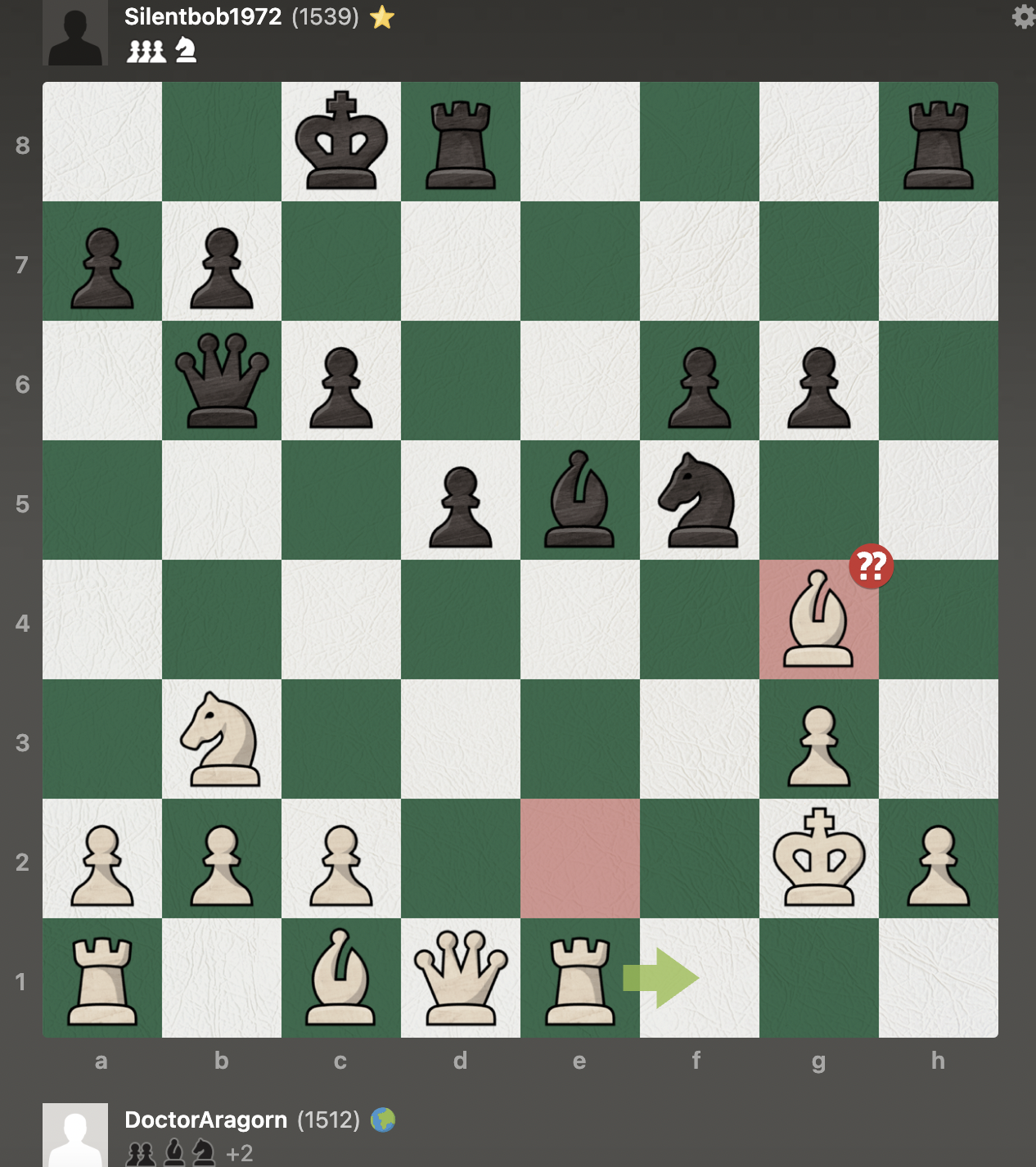
In a game that ended on February 2, 2023, I was playing as white. This game began with the Caro-Kann opening and proceeded with the Advance Variation.
In the middlegame, I had exposed my king, and both sides had missed a few big opportunities.
On move 18, I played Bg4. I thought it was good because it pins the knight on f5 to the black king, while also revealing an attack from the e1 rook on black’s dark-squared bishop.
This move, however, was a blunder. It allows mate in 5.
Can you find the mating sequence?

Rxh2+, a rook sacrifice!
White’s king is in check, so there are only 3 possible moves. Kf1 falls into an immediate checkmate with Qf2#. Kf3 also runs into an immediate checkmate with Rf2#. The only other option is to accept the sacrifice with Kxh2, and that is what I played.
My opponent then followed up with Qf2+. Kh3 would lead to an immediate checkmate with Qxg3#, so instead I played the only other legal move: Kh1.
My opponent then played Rh8+. I blocked with Bh6. He took with Rxh6+. I blocked with Bh5, releasing the black knight from the pin. Thus my opponent played Nxg3#.
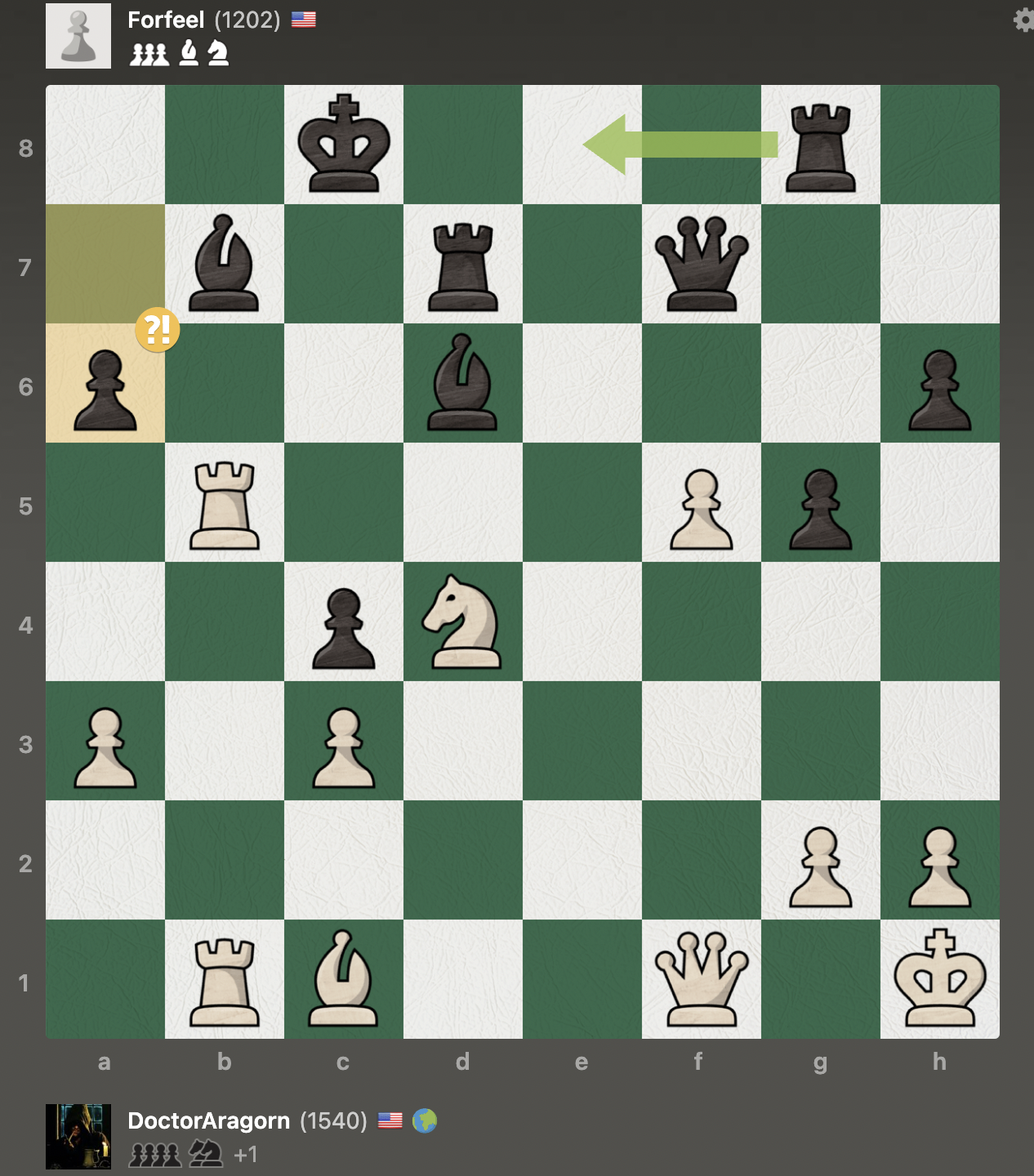
Lastly (for now), in a game that ended on February 17, 2023, I was playing as white. The game began with the Italian Game opening.
After several missed opportunities on both sides in the middlegame, on move 31 my opponent played a6, threatening my rook.
If you were playing as white, what would you do in this situation?

Rxb7, sacrificing the exchange!
After my opponent recaptures with his rook (Rxb7), then I recapture with my other rook (Rxb7).
My opponent should then have recaptured with his king (Kxb7), which would have allowed my queen to check him with Qf3+ and then go onto the attack.
Instead, however, he fell into my trap and played Qxb7. This allowed me to then play Qxc4+, forking the king and the rook.
He played Kb8, which allowed me to take the rook with check on the next move: Qxg8+.
He played on until move 43, when I played a move that allowed me to win his queen. He then resigned.
I hope you were able to exercise your problem-solving skills through these puzzles, as well as appreciate the brilliant moves that were made.
If you play chess and have brilliant moves you want to share with me, feel free to send them my way!

